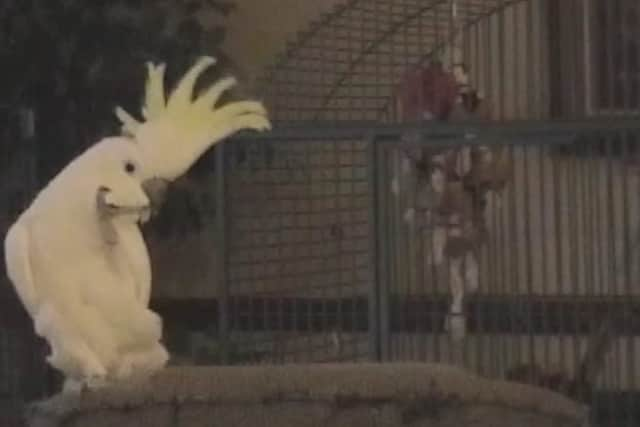Watch: this dancing cockatoo taught itself 14 different moves


A dancing cockatoo who became a YouTube sensation has added two eighties classics and 14 different moves to his rock repertoire.
The sulphur-crested cockatoo's uncanny abilities have now impressed researchers too, who are back with new evidence that Snowball isn't limited in his moves.
Advertisement
Hide AdAdvertisement
Hide AdAnimals can dance too


They say Snowball's impressive displays show that dancing to music isn't an arbitrary product of human culture, but a response that arises when certain cognitive and neural capacities come together in animal brains.
The researchers suggested that some shared traits between parrots, such as a tendency to form long-term social bonds, vocal learning and the ability to learn complex action sequences, may be the reason behind Snowball's ability to dance.
Despite a lack of dance training, new videos show Snowball using 14 different moves - including the 'headbang', 'body role' and 'down shake' .
The feathered floor burner first shot to fame in 2007 with a video of him rocking out to the Backstreet Boys' hit Everybody (Backstreet's Back) being viewed nearly two million times on YouTube.
Advertisement
Hide AdAdvertisement
Hide Ad

His moves a decade ago included bobbing his head along to the beat, kicking his leg in the air and stamping his feet.
The videos show Snowball responding to music with "diverse and spontaneous" movements using various parts of his body, leading researchers to conclude that his moves are more than an entertaining novelty act.
Study senior author Professor Aniruddh Patel, a psychologist at Tufts University and Harvard University in the US, said: "What's most interesting to us is the sheer diversity of his movements to music."
He said Snowball developed those moves, much richer than the head bobbing and foot lifting they'd studied before, without any training.
Advertisement
Hide AdAdvertisement
Hide AdProfessor Patel's earlier study, also published in the journal Current Biology, confirmed that Snowball could move to the beat, which was notable in part because dancing is a natural ability in humans that's absent in other primates.
Soon after that study, Snowball's owner and an author on the new paper, Irena Schulz, noticed that the bid was making movements to music she hadn't seen before.
That gave the researchers the chance to study another potential similarity between Snowball's movements and human dancing - diversity in the movements and body parts used when responding to music.
To quantify Snowball's movement diversity, Professor Patel's team filmed Snowball grooving to Another One Bites the Dust and Girls Just Want to Have Fun, playing each of the tunes for him three times for a total of 23 minutes.
Advertisement
Hide AdAdvertisement
Hide AdAt the time, Snowball was 12 years old and had not danced to those songs with anyone other than his owner.
During filming, Schulz, a molecular biologist, was in the room shouting an occasional 'good boy' - but Snowball was the only one in the room dancing.
Why does Snowball dance?
Unlike the way humans normally dance, Snowball tended to dance in snippets of about three or four seconds - each time he heard a particular tune he danced a little differently, a sign of flexibility and perhaps even creativity.
Snowball isn't the first parrot to move to the music, but there has been uncertainty about how such moves are acquired.
Advertisement
Hide AdAdvertisement
Hide AdThe researchers proposed that the reason humans and parrots share a natural ability to dance may arise from the convergence of five traits - vocal learning, the capacity for nonverbal movement imitation, a tendency to form long-term social bonds, the ability to learn complex sequences of actions, and attentiveness to communicative movements.
For humans, dancing is a form of social interaction - people more often dance with other people than they do alone.
Professor Patel says they are currently analysing data from an experiment designed to find out whether the same is true of Snowball.